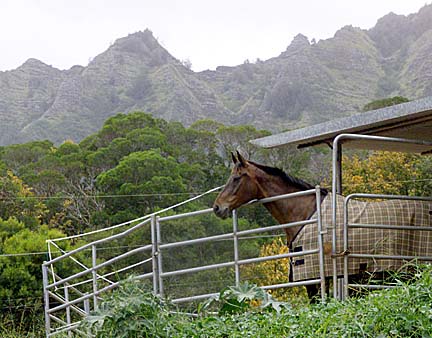


Greek mythology tells of the magnificent winged horse Pegasus, whom mortals admired but, save for the young hero Bellerophon, could not capture. The elusive Pegasus could be galloping across a meadow one minute and dancing with the moon the next.
You can lead a horse
By Cheryl Chee Tsutsumi
to water, but can you
make him dance?
Special to the Star-BulletinNo horse that walks the earth today can fly, of course, but there are many that can dance. As nimble and fleet as Pegasus, these powerful animals -- 1,100 pounds of pure muscle -- can do pirouettes and piaffes with the poise and grace of a ballerina.
Dressage to music or Kur, a German word that literally means "optional exercise," is "interpretive dance on horseback," says Suzi Hillis, manager of Hilltop Stables in Waimanalo, which will be presenting a free Kur show from 9 to 11 a.m. Saturday. "The rider takes the lead, the horse follows. Just about any kind of music with a nice rhythm can work: classical, movie soundtracks, Broadway show tunes, even pop rock and big band.

"The Kur is a lot more difficult than it looks. The rider must have mastered the basic movements of dressage, and he must have a good rapport with the horse so they perform as one, with the ease and fluidness of a couple doing a waltz," Hillis said.Never mind that the horse may stand a foot taller and weigh 10 times more than its rider. In a well-executed musical dressage program, equestrian and mount are as much in synch as Fred Astaire and Ginger Rogers.
The ancient Greeks were the first to practice dressage; their intricate exercises were captured in friezes at the Parthenon in Athens, which dates back to the 5th century B.C. When their empire died, however, so did the popularity of the sport. Dressage was not revived until 14th century Italy, when the Renaissance brought a rebirth of the arts, including horsemanship.
From Italy, dressage spread across the continent, with the gentry taking it up with great enthusiasm. Noblemen regarded dressage as a way to flaunt their machismo and equestrian skills, while ladies enjoyed dressing in lavish attire and riding to music. Over the next 300 years, such theatrical dressage was a favored form of entertainment among the European aristocracy.
In modern times, dressage to music received little attention until 1986, when the World Cup for Dressage was established, requiring competitors to complete one Grand Prix (standard) test and one Kur (freestyle) test, both carrying equal weight. From then on, the popularity of the Kur skyrocketed, so much so that in 1996, it was added to the dressage format for the Olympic Games in Atlanta.
Initially, top trainers and riders did not want the musical freestyle to be a part of major competitions; because it encourages creativity and reflects the individual personalities of the horse and rider, they felt the traditional criteria of judging dressage would change.
To ensure this would not happen, judges assess the technical aspects of the Kur program critically. The horse's movements must be energetic, clearly defined and accurately performed. In addition, judges carefully evaluate the rhythm and impulsion of the horse's gaits, as well as the harmony of the team.
Hillis, who's been instructing riders at Hilltop Stables for 17 years, has performed musical freestyles in numerous competitions.
"The difficulty," she says, "is maintaining your concentration and looking composed and confident at the same time. Aids -- the body and leg commands you use to communicate with your horse -- must be given subtly. Judges are watching how crisp the horse's steps are, and how well it moves to the music. The horse's front legs must always move to the beat of the music."
According to Hillis, choosing appropriate numbers is a challenge. "First, you need to consider the appearance of the horse. You wouldn't want to have a small, delicate horse performing to a soundtrack with a lot of loud brass. Likewise, you wouldn't want a big, muscular horse performing to a soft, sweet sonata. Also, the tempo of the music should match the tempo of the horse's gaits. Your program should combine selections with different tempos to show the horse at the walk, trot and canter. Only instrumental music is used because vocals tend to be distracting."
When developing a Kur program, riders should consider the ability and experience of their horse. "Just like humans, some horses are naturally more talented, supple and athletic than others," Hillis notes. "You need to know what your horse's capabilities and weaknesses are, and put him in the best possible light."
As in freestyle ice skating, competitors in the Kur are required to execute specific movements within a set period of time (usually 5 minutes), the order of which is entirely up to them. This is where choreography -- the artistic component of dressage to music -- comes in. "You can do all the mandatory movements, but in a sequence that highlights your horse's strengths," Hillis says.
"Putting more movements in a routine doesn't necessarily make it better. You want your choreography to be interesting and imaginative without being busy."
The Hawaii Dressage and Combined Training Association sponsors dressage shows 10 times a year on Oahu. With riders of all ages and levels of experience participating, they are excellent introductions to the sport, which has been part of the Olympic Games since 1912. "You don't have to be a 'horse person' to enjoy watching dressage," Hillis asserts. "Add music and it takes on a whole nother element of drama and excitement."
Showtime: 9 to 11 a.m. Saturday Dressage to Music
Place: Hilltop Stables, 41-430 Waikupanaha St., Waimanalo
Admission: Free
Call: 259-7843
Click for online
calendars and events.